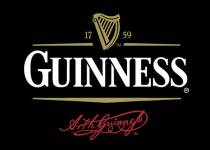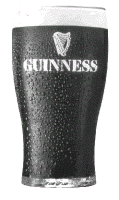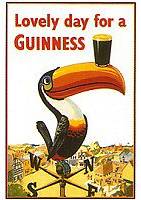March 2006
Guinness
What better time to write an article about beer then St. Patrick’s Day (by the time this is posted everyone will be sober, my fault entirely, researching). He founded Ireland's monasteries, which established the tradition of ale brewing. It has been said that St. Patrick arrived in Ireland bringing his own brewer with him. Not a bad idea. A person who chases away snakes must get pretty thirsty.
 No beer is more associated with the Celtic holiday then Guinness.
Guinness is currently Ireland’s most famous
export (next to U2). Guinness gets its name from founder Arthur Guinness.
Arthur began brewing beer in 1752. In 1759 he bought a disused abbey in Dublin and Guinness has been brewed there ever since.
Originally Guinness
brewed amber ales. It wasn’t until Ireland started importing
English Porter beer, which was very popular at the
time, that Guinness created their own English Porter style beer.
This Irish company quickly dropped the label
English Porter beer and simply called it Porter. The first batch of the Guinness Porter was brewed in the 1770’s
at the St. James Gate brewery. By 1799 Arthur Guinness started brewing Guinness Porter exclusively.
No beer is more associated with the Celtic holiday then Guinness.
Guinness is currently Ireland’s most famous
export (next to U2). Guinness gets its name from founder Arthur Guinness.
Arthur began brewing beer in 1752. In 1759 he bought a disused abbey in Dublin and Guinness has been brewed there ever since.
Originally Guinness
brewed amber ales. It wasn’t until Ireland started importing
English Porter beer, which was very popular at the
time, that Guinness created their own English Porter style beer.
This Irish company quickly dropped the label
English Porter beer and simply called it Porter. The first batch of the Guinness Porter was brewed in the 1770’s
at the St. James Gate brewery. By 1799 Arthur Guinness started brewing Guinness Porter exclusively.
Arthur Guinness had a son who he named Arthur (good thinking Dad). Son Arthur created a new style of porter in 1820, which he called Extra Stout Porter (later simply known as Stout). This is the recipe closest to today’s Guinness Extra Stout. It very quickly caught on and soon the Irish market was fully saturated. This led to massive exports to England, Continental Europe, America, Australia and the world. Wherever there was an Irishman to be found there was Guinness.
The great ad campaign that was launched by Guinness with such phrases as “Guinness is good for you” caught on and also helped sales. The Guinness Toucan (see below) and the Ostrich with a pint of Guinness lodged in its throat (see below) and other commercials were all very popular. These ads can still be found in many of our pubs and bars in Toronto and the world.



The expansion of Guinness continued under Arthur’s son Benjamin. He turned St. James Gate into the largest brewery in the world. Finally due to the demand in England a second Guinness Brewery opened in Park Royal London in 1936. Guinness had actually reversed the beer trade sending exports to England rather then importing from England. By 1959, 60% of the production at St. James Gate was for export. In 1962 the first Guinness brewery was built outside the British Isles in Nigeria, Africa. Since then they have opened breweries in Malaysia, Cameroon, Ghana and Jamaica. The strength of Guinness stout varies depending on the market. Stronger versions are brewed for export. Sweeter versions are popular in Africa and the Caribbean. Altogether Guinness is brewed in 50 countries and is on sale in a further 100.
INTERESTING FACTS
- In the 1980’s the family interest in the business declined to 5% as the company expanded by taking over other beer and liquor-producing companies.
- The Guinness porter was getting so popular that wounded soldiers from the battle of Waterloo were asking for it by name in 1815
- In 1862 Guinness added the harp symbol to their label. It’s been their recognizable trademark ever since.
- Stout still accounts for around ½ of all the beer sold in Ireland, although it is not it’s best selling beer
For more information on Guinness go to:
http://www.guinness.com/row_en/
Web sites of interest:
© 2006 (MR) roecken.ca

